Capturing Flamborough’s Wild Beauty: The Ultimate Landscape Photographer’s Guide
Flamborough Head offers exceptional photography opportunities with its white chalk cliffs, dramatic seascapes, diverse wildlife and unique geological features. This guide provides practical photography advice for capturing this striking Yorkshire coastline, covering optimal shooting locations, equipment recommendations and seasonal considerations.
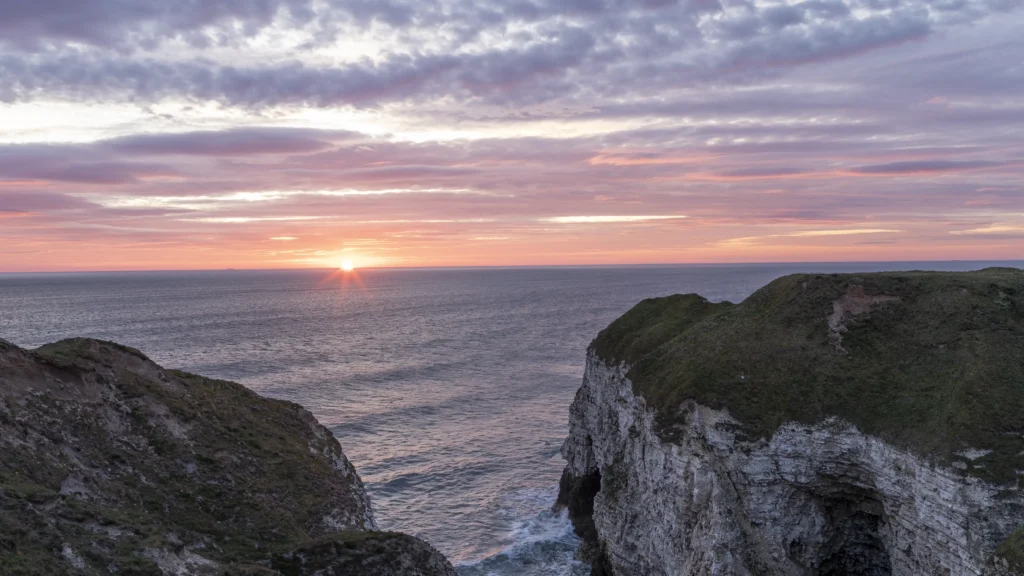
Coastal Sunrise Photography
Sunrise at Flamborough Head offers beautiful lighting conditions for landscape photography, with the east-facing coastline perfectly positioned to capture golden hour light on the chalk cliffs.
For the best sunrise photos, arrive about 30-45 minutes before official sunrise to capture the changing colours in the sky. Selwicks Bay provides one of the best sunrise locations, with its distinctive chalk arch and sea stack creating strong visual interest.
A tripod is very helpful for sunrise photography, allowing you to use slower shutter speeds in the low light conditions. This can create smooth, misty effects with the water as waves recede around the rocks. A 4-stop (1.2) hard graduated neutral density filter is essential for sunrise photography at Flamborough unless you intend to bracket your exposures and edit them together in Photoshop afterwards. The hard grad will help balance the bright sky with the darker foreground, allowing you to capture the scene in a single exposure with natural-looking results.
If you have a polarizing filter, it can help reduce glare on wet surfaces and enhance the colours in the scene, though be careful when using it with a wide-angle lens as it can create uneven effects across expansive skies.
Try different compositions – wide shots to capture the entire bay and cliff formations, as well as closer details of interesting rock formations or patterns in the water. Including foreground elements like rock pools can add depth to your images.
In winter months, sunrise is at a more reasonable hour (around 8am) compared to summer when it can be as early as 4:30am. The effort of an early start is usually rewarded with beautiful light and fewer people around.
After capturing your sunrise photos at Selwicks Bay, you can easily make your way to North Landing to photograph the seals at the Drinking Dinosaur rock formation, creating a perfect morning of photography that combines landscape and wildlife opportunities.
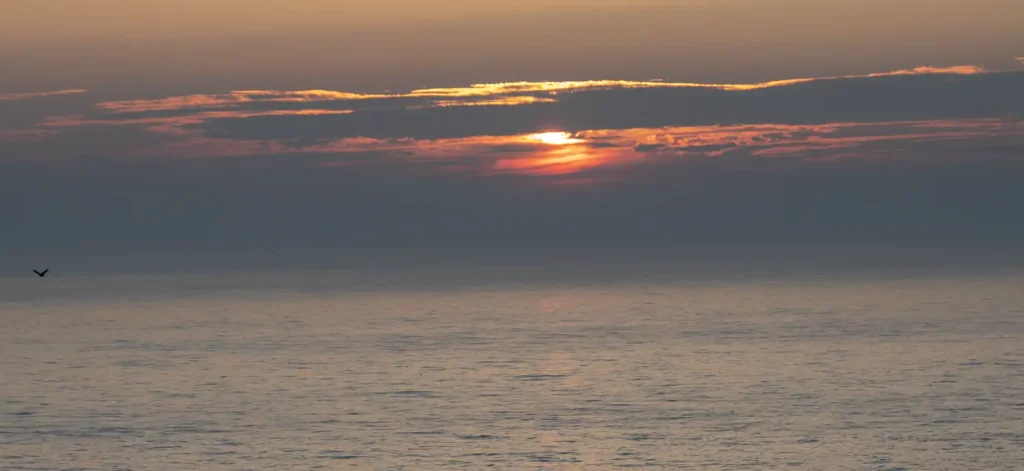
Wildlife Photography: Seals at the Drinking Dinosaur
Near North Landing is a distinctive rock formation known locally as the “Drinking Dinosaur,” which provides excellent opportunities to photograph grey seals throughout the year, with autumn and winter offering the most reliable sightings.
Seals are often spotted hauling out onto rocks during lower tides, so checking tide times before your visit can be worthwhile. Early mornings typically provide quieter conditions with fewer visitors, giving you a better chance to observe natural behaviour.
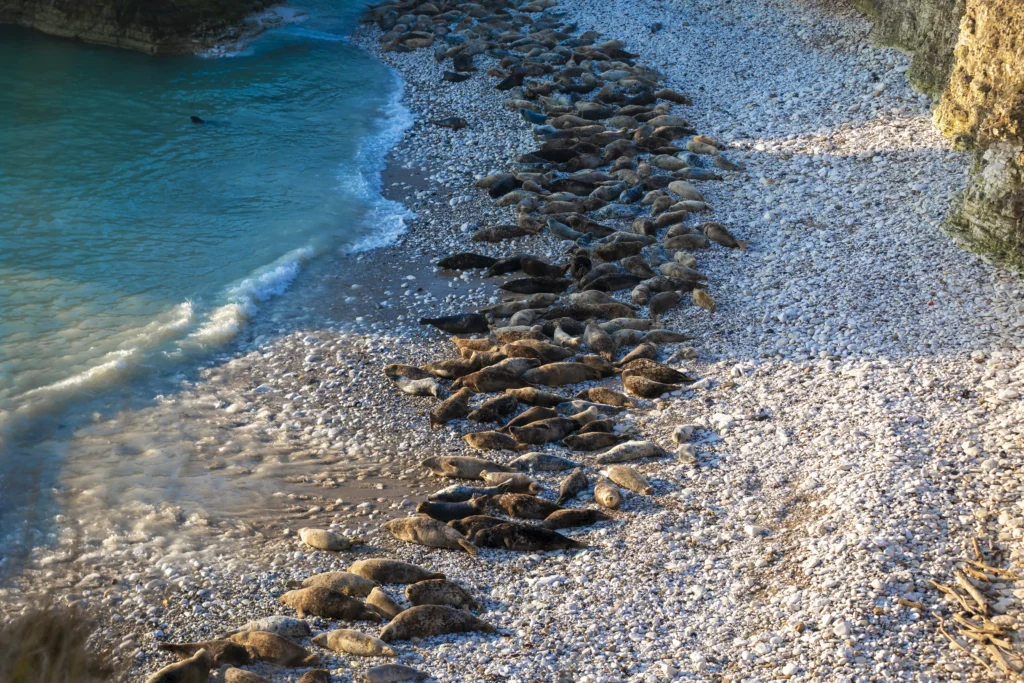
A telephoto lens is useful for wildlife photography, but you don’t need professional equipment – a standard zoom lens with some reach (such as a 55-200mm or 70-300mm) will allow you to capture decent images while maintaining a respectful distance. If you don’t have a long lens, quality binoculars can provide enjoyable viewing.
When photographing seals, patience is key. Find a comfortable position, stay still, and wait for natural behaviour to unfold. The seals are often curious and may provide wonderful photographic opportunities as they rest on rocks or swim nearby.
During pupping season (November-January), it’s especially important to keep your distance and avoid disturbing the animals. Always observe wildlife ethically, putting their welfare above getting the perfect shot.
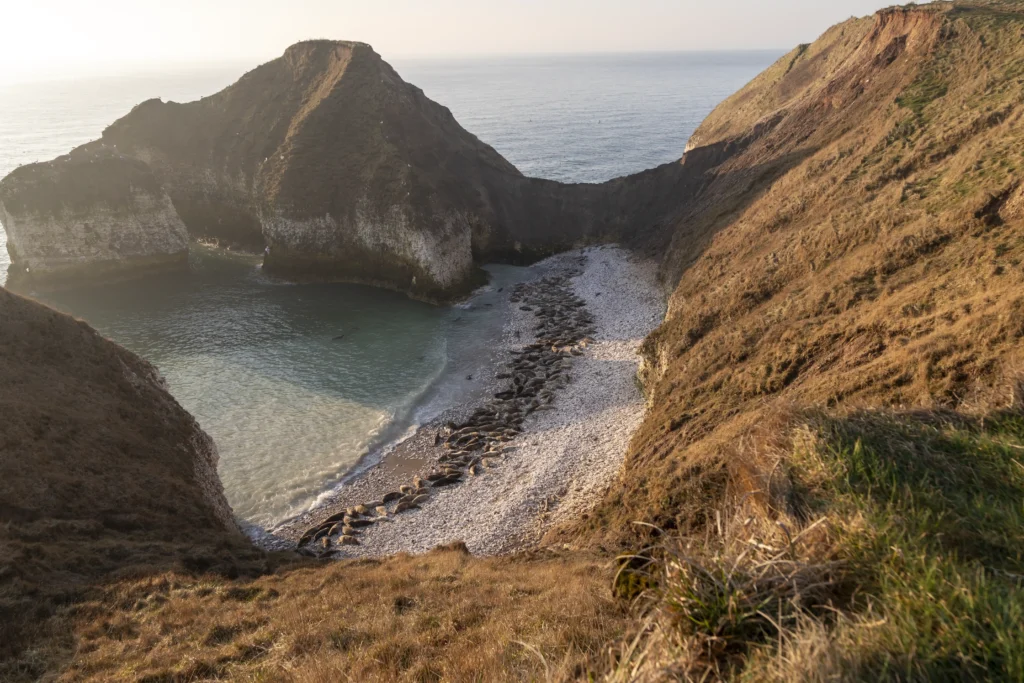
Puffin Photography at Bempton Cliffs
Just a short distance north of Flamborough (about 4 miles) lies Bempton Cliffs RSPB reserve, home to one of Britain’s most accessible seabird colonies. Between April and July, the cliffs become home to hundreds of thousands of seabirds, with the charismatic puffins being a particular favourite for photographers.
You’ll find puffins at Bempton between April and mid-July, with May and June being the peak months when they’re most active, returning to their burrows with beaks full of sand eels for their young. These moments create classic puffin images that many photographers hope to capture.
The RSPB has created several excellent viewing platforms along the clifftop that allow close observation without disturbing the birds. A zoom lens is helpful here, as the birds can be some distance away on the cliff face. Even a modest telephoto lens will let you capture some pleasing images, particularly when birds fly close to the platforms.
Wind direction affects bird photography at Bempton – seabirds typically land into the wind, so a moderate onshore breeze often brings them closer to the viewing platforms as they hover briefly before landing. These moments provide good opportunities for photographs.
Early morning and evening visits often provide better light and coincide with periods of increased feeding activity. Weekdays are typically quieter than weekends, giving you more space at the viewing platforms during busy seasons.
While puffins are the stars for many visitors, don’t overlook the other seabirds – gannets, guillemots, razorbills, kittiwakes and fulmars all offer distinctive photographic subjects and are often easier to photograph than the smaller, faster puffins.
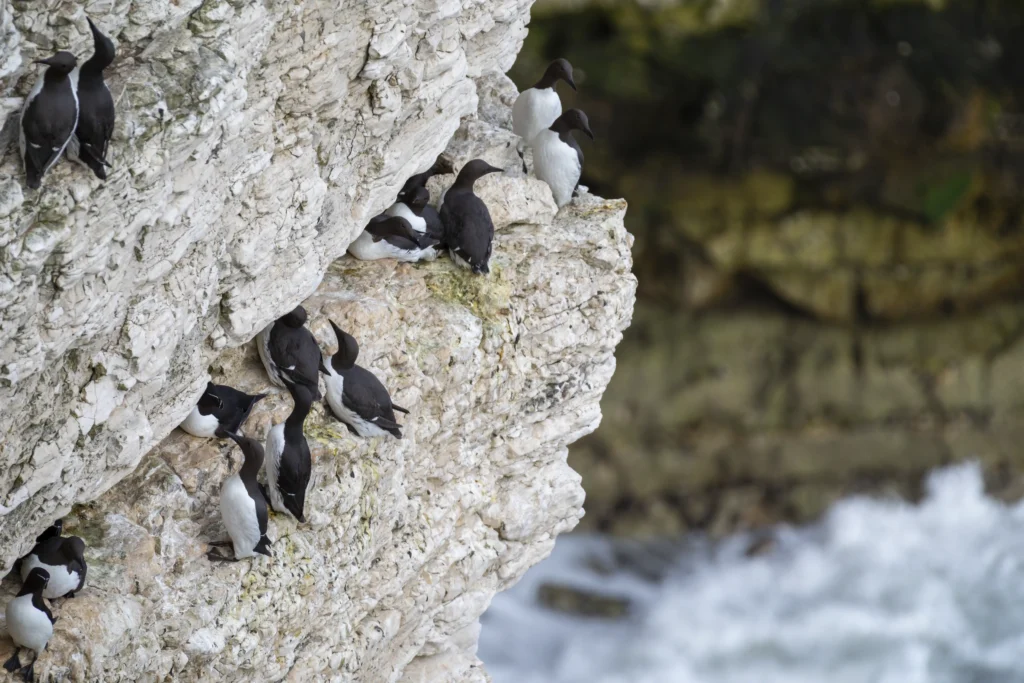
The RNLI at Flamborough
The Royal National Lifeboat Institution (RNLI) has a rich history in Flamborough. Historically, there were two lifeboat stations at Flamborough – one on the north side of Flamborough Head at North Landing, and one on the south side. The North Landing station closed in 1993, leaving just the southern station in operation. The remaining RNLI station currently operates a B-class Atlantic 85 inshore lifeboat named “Elizabeth Jane Palmer” (B-820), which has been on station since 2007.
For photographers, the distinctive orange of the lifeboat provides a striking visual element against the natural backdrop of white cliffs and blue sea. The old lifeboat house at North Landing, though no longer operational, makes an interesting historical feature in photographs of the area.
The station conducts practice launches typically every fortnight, which offer excellent photography opportunities as the boat speeds into the water. These events combine action, colour and human interest in a single subject.
You’ll want a reasonably fast shutter speed to capture the movement of the boat, but most standard camera equipment is perfectly adequate for capturing these moments. Early morning light can be particularly effective for lifeboat photography, creating dramatic side-lighting that highlights the vessel’s form against the water.
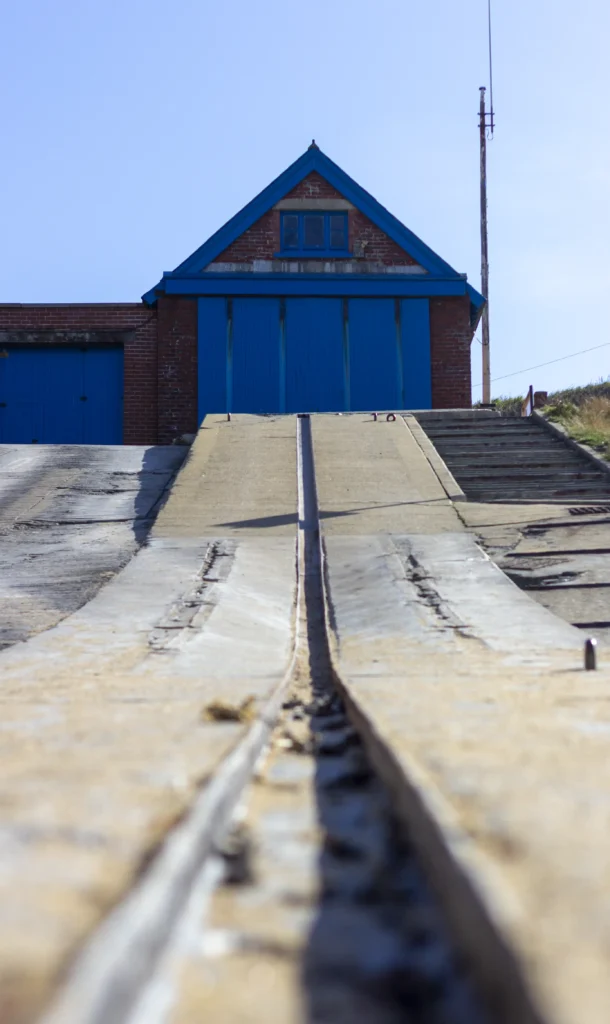
North Landing: A Photographer-Friendly Base
North Landing provides an excellent base for exploring Flamborough Head’s photographic opportunities, with practical facilities that make extended photography sessions much more comfortable.
The location offers a good-sized car park just a short walk from the beach, making it easy to bring your photography equipment without a lengthy hike. This accessibility is particularly welcome when you’re carrying a camera, lenses and tripod, or if you’re planning to stay for sunrise or sunset.
Between photography sessions, the welcoming café provides a perfect retreat for refreshments and warming up, especially welcome after an early morning shoot or during changeable weather. The café is typically open daily during the main season, with reduced hours during winter months.
The beach at North Landing is nestled between impressive chalk cliffs, offering numerous compositional possibilities. Distinctive chalk formations provide strong focal points, while the varied textures of pebbles and rock pools create interesting foreground elements. At lower tides, sea caves and additional geological features become accessible, though always be mindful of tide times to avoid being cut off.
For those with mobility considerations, the path to the viewing area is relatively gentle, though the final access to the beach itself involves some uneven terrain. For photographers who find steep coastal paths challenging, North Landing offers one of the more accessible options for capturing Flamborough’s coastal beauty.
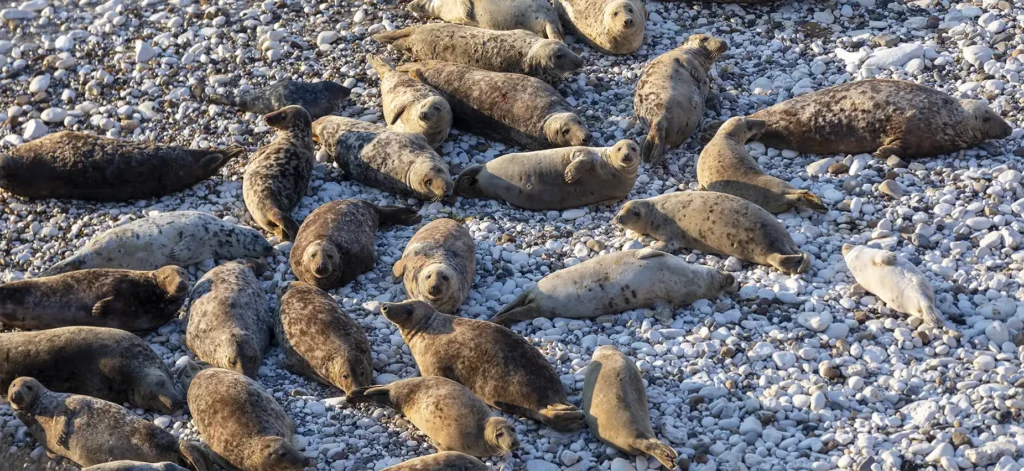
Flamborough Lighthouse and the Drinking Dinosaur
One of Flamborough’s most iconic landmarks is its lighthouse, located on the eastern side of the headland near Selwicks Bay. The Drinking Dinosaur rock formation can be found further along the headland at North Landing. Flamborough Lighthouse stands 27 metres tall and has been guiding ships since 1806, making it an important historical feature as well as a photographic subject.
The lighthouse creates a classic focal point for landscape compositions, particularly when photographed against dramatic skies or during golden hour when the white tower takes on warm amber tones. Its position on the headland allows for various creative approaches – you can capture it from below along the cliff path, from a distance along the headland, or as a backdrop to the wild coastal scenery.
Although the lighthouse and the Drinking Dinosaur rock formation are both notable Flamborough landmarks, they are located in different areas of the headland and cannot be captured in the same frame. Each offers its own distinct photographic opportunities – the lighthouse with its cultural and historical significance, and the Drinking Dinosaur with its unique natural shape and wildlife.
Access to the lighthouse area is straightforward, with a car park nearby making it easy to visit at sunrise or sunset when the light is most dramatic. The surrounding grassland offers unobstructed views and plenty of space to set up a tripod without crowds, particularly in the off-season or early mornings.
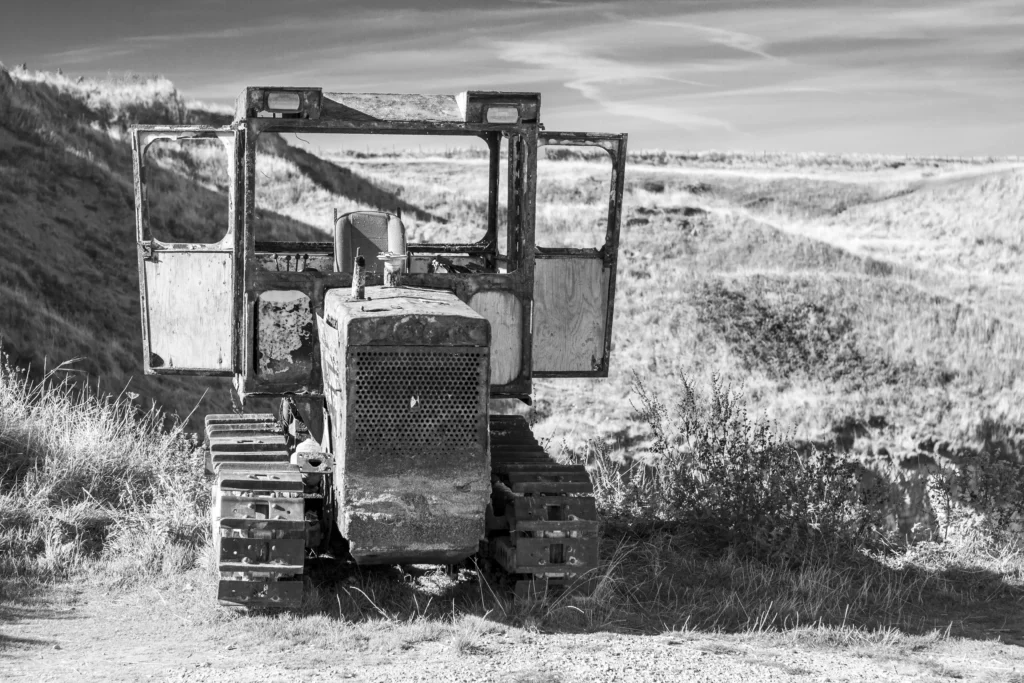
Exploring Thornwick Bay and Selwicks Bay
While North Landing provides excellent accessibility, the neighbouring bays of Thornwick and Selwicks offer some of Flamborough’s most dramatic coastal landscapes for photographers willing to explore a bit further.
Thornwick Bay features a dramatic cove with imposing cliffs that create a sense of enclosure, working beautifully in wide-angle photographs. The bay includes a distinctive sea arch and several caves that become accessible at lower tides. Morning light can be particularly effective here, as the rising sun illuminates the eastern cliff face while leaving the western side in shadow, creating appealing contrast in your images.
From the small promontory separating the main bay from Little Thornwick Bay, you can capture elevated views across both inlets. These higher vantage points allow you to showcase the layered nature of the headlands stretching into the distance.
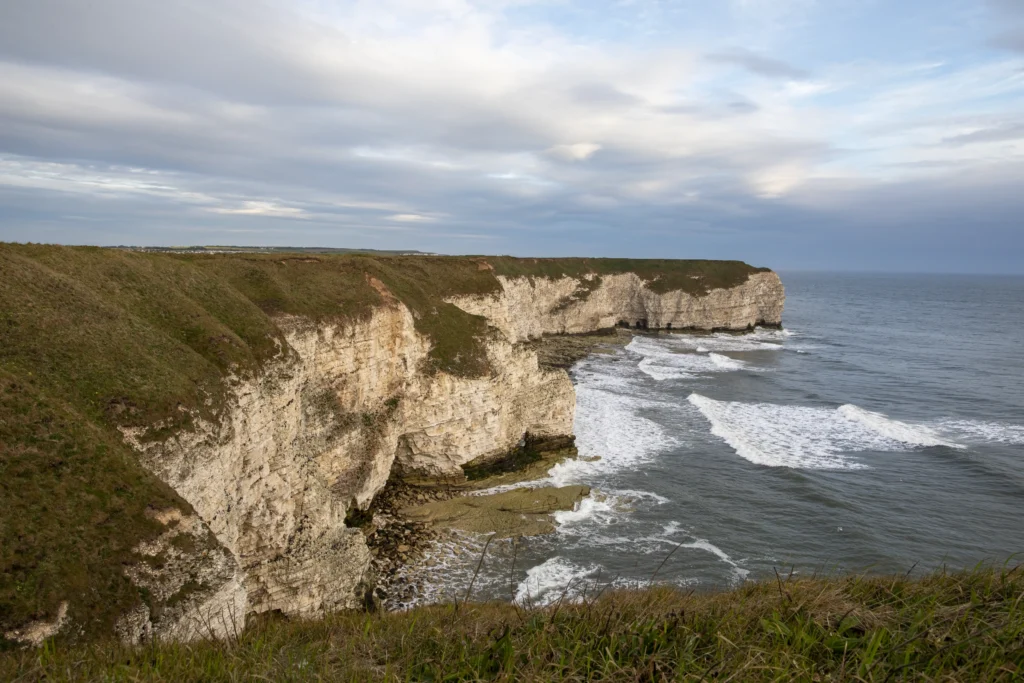
Selwicks Bay represents perhaps the quintessential Flamborough landscape with its distinctive chalk arch and sea stack. While easily photographed from the clifftop, more adventurous photographers can descend the steep steps to beach level, where the massive scale of these formations becomes truly apparent.
What makes these locations particularly valuable is their different orientations – Selwicks Bay faces east (perfect for sunrise), while Thornwick’s north-easterly aspect works well for both early morning and evening light depending on the season. This variety means you can almost always find somewhere with favourable lighting conditions.
Don’t limit yourself to fair weather photography. Some of the most dramatic images of Flamborough come during stormier periods when powerful waves crash against the headlands. Always prioritise safety – never risk dangerous positions for a photograph – but shooting from secure vantage points can yield spectacular results.
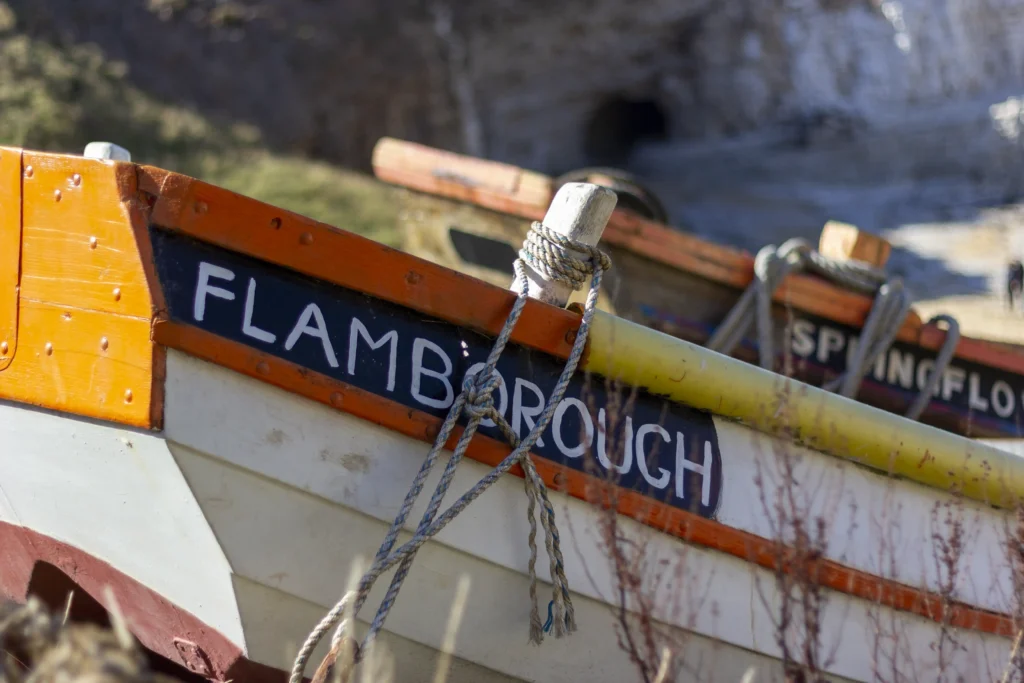
Seasonal Opportunities at Flamborough Head
Flamborough Head offers different photographic opportunities throughout the year, making it worth multiple visits to capture its changing character across the seasons.
Winter
Winter brings dramatic weather conditions that can transform Flamborough’s coastline. Stormy days create powerful wave action against the chalk cliffs, producing spectacular photography opportunities. The low winter sun casts beautiful golden light across the landscape, and sunrise occurs at a more reasonable hour (around 8am) compared to summer months. The cliffs often look particularly striking against darker skies, and you might catch sight of grey seals with their pups at the Drinking Dinosaur.
Spring
As spring arrives, the clifftop vegetation begins to green, creating an attractive colour contrast with the white chalk. Late April marks the return of puffins to Bempton Cliffs, and other seabirds begin establishing nesting sites. Morning mist becomes more common in April and May, sometimes creating atmospheric conditions where the cliffs emerge from the haze. Weather patterns become increasingly stable, making photography more predictable.
Summer
Summer brings the peak of seabird activity at Bempton Cliffs, with June being optimal for puffin photography as they busily collect sand eels for their young. The extremely early sunrise (around 4:30am) requires commitment but rewards with beautiful light and tranquil conditions before other visitors arrive. The longer daylight hours allow for extended exploration of the coastline, though midday light can be harsh for landscape photography.
Autumn
As autumn approaches, stormy conditions gradually return, creating opportunities for dramatic seascapes. Morning sea fog becomes more frequent, sometimes creating beautiful conditions where the lighthouse emerges from the mist. Bird migration periods bring additional wildlife subjects, and the changing colours of vegetation add visual interest to cliff-top compositions. The days shorten, making sunrise photography more accessible again.
Practical Equipment and Recommendations
Practical Photography Equipment:
- A reliable camera (DSLR or mirrorless)
- General purpose zoom lens (something like 18-55mm or 24-105mm)
- Longer zoom if you have one (70-300mm is plenty for most wildlife)
- Sturdy tripod for sunrise/sunset shots
- Memory cards with sufficient capacity
- Spare batteries
- Basic filters if you have them (polarizer and maybe an ND filter)
- Camera bag with rain protection
- Lens cleaning cloth (coastal spray makes this essential)
- Comfortable walking shoes/boots
- Weather-appropriate clothing (layers recommended)
- Torch or headlamp for early morning/evening shooting
You don’t need expensive gear to capture beautiful images at Flamborough. Many photographers achieve excellent results with entry-level cameras and kit lenses. The best camera is the one you have with you, so even a smartphone with a decent camera can capture memorable landscapes, especially in good light.
Conclusion: Endless Photographic Possibilities
Flamborough Head is a true gem for landscape photographers, offering an incredible variety of subjects within a relatively compact area. From dramatic chalk cliffs and seascapes to charismatic wildlife and maritime heritage, the photographic opportunities are virtually limitless.
What makes Flamborough so special is how its character transforms throughout the seasons and even throughout the day. The changing tides reveal new features, the shifting light brings out different aspects of the landscape, and the weather conditions dramatically alter the mood of your photographs.
For photographers visiting Yorkshire’s coast, Flamborough deserves not just a single visit but repeated exploration throughout the year. Each return reveals new perspectives, different light, and fresh creative possibilities. The combination of spectacular natural features and practical facilities makes it an ideal location for photographers of all experience levels.
Whether you’re capturing the perfect sunrise at Selwicks Bay, photographing puffins at Bempton Cliffs, or documenting the RNLI’s vital work, Flamborough offers a photographic experience as varied as it is inspiring. Pack your camera, check the weather and tide times, and prepare to be captivated by one of Britain’s most photogenic coastlines.

